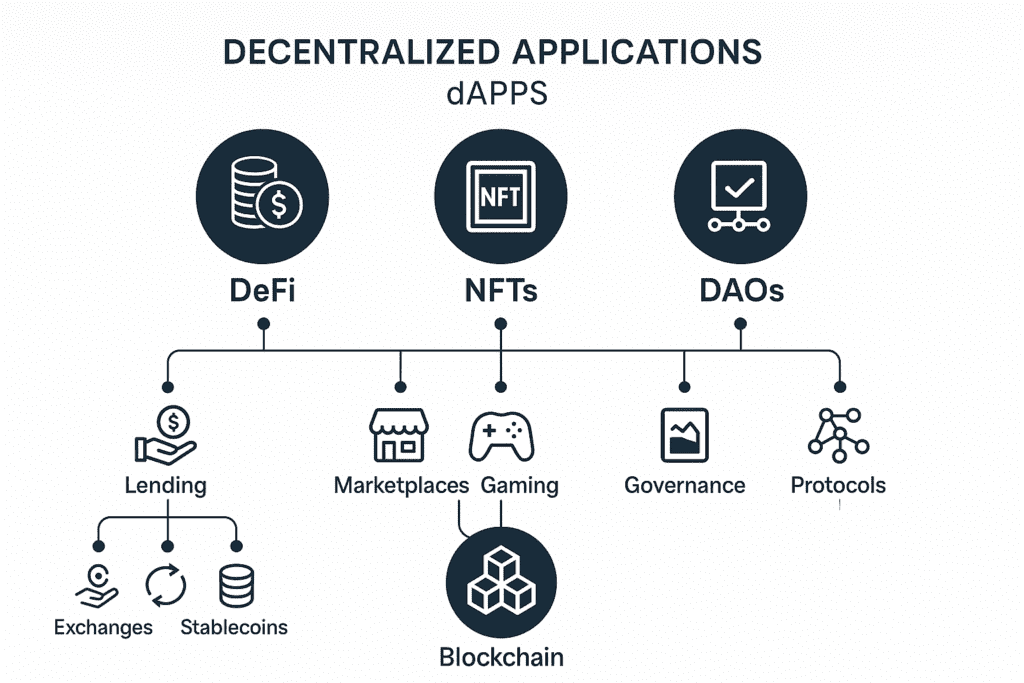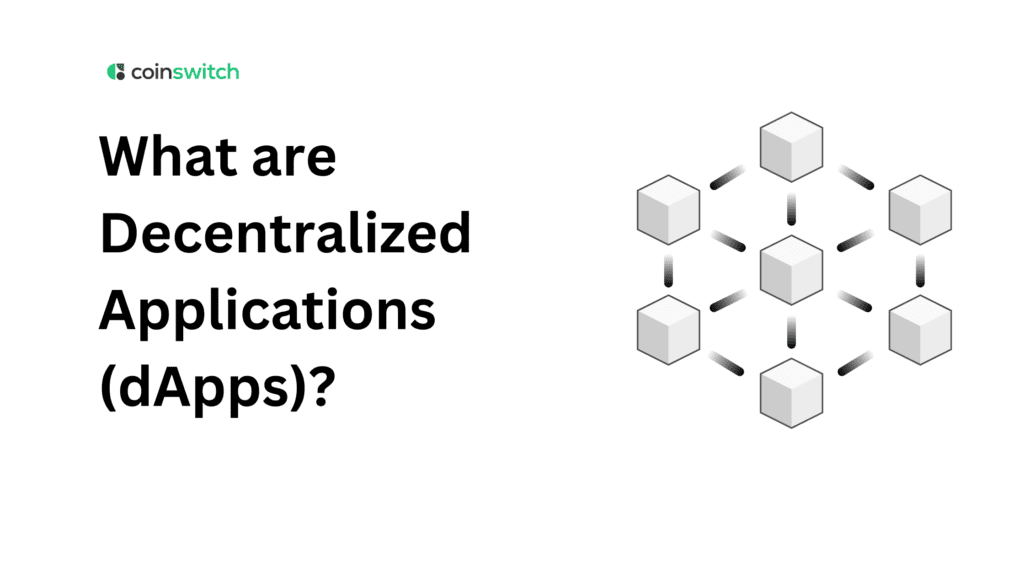Digital programs or software applications that run on a blockchain or a peer-to-peer (P2P) network are called decentralized applications, or dApps. They don’t depend on a single authority like regular apps do. Instead, they are directed by users across the network as a whole. Additionally, developers create most dApps on blockchains like Ethereum. People use them for various purposes, such as wallets, exchanges, and gaming. Some dApps also have tools for managing your money and autonomous social networks. Let’s understand what dApps are in detail.
What Are dApps?
An application that runs on a blockchain network instead of a centralized computer is called a decentralized application (dApp). They are different from regular apps because they use blockchain to provide more security, privacy, and user control. Instead of keeping data and control on a single computer, these apps spread it out across several nodes.
When you use a dApp, your actions are recorded on the blockchain and checked by the whole network, not just one person or group. This makes hacking less likely. Additionally, dApps serve various purposes, including banking, gaming, tracking supply chains, facilitating voting, and creating digital art.
Understanding dApps
Traditional web apps, like Uber or X (formerly Twitter), use centralized methods. A single business owns and runs the computers that store these apps. Besides, the company has complete power over the back end of the app and can decide how it works. The group that built the tool still has power, no matter how many people use it. This controlled approach means that users can only access and use the app through the company.
Decentralized apps, or dApps, work differently. They use blockchains or peer-to-peer (P2P) networks to function. Besides, well-known P2P apps like Popcorn Time, BitTorrent, and Tor let users share and access material without using a central server. Users actively participate in these platforms by sending, receiving, or using data across a spread network. DApps use blockchain technology to apply the same idea, making a space where control is shared among users instead of being controlled.
Importance of dApps
It is expected that the market for digital assets will generate US$100.2 billion in revenue by 2025. This shows how blockchain technology is becoming more popular. The rising acceptance of Decentralized Applications (dApps) is a significant factor in this trend. Additionally, decentralized apps, or dApps, are changing the way people connect with technology by making things more open, safe, and user-controlled. This makes online services more open, accessible, and effective for everyone.
Better Security
DApps use blockchain’s cryptographic algorithms and decentralized data storage to protect against hacks. Here, data is distributed across multiple nodes, reducing the risk of a single point of failure.
Getting Rid Of Intermediaries and Lowering Costs
DApps let users interact with each other directly, without going through banks, intermediaries, or service providers. With peer-to-peer platforms, there are no extra costs. Besides, it gets faster and cheaper to do business. It’s suitable for both companies and customers.
More Privacy and Control for Users
Data storage for dApps is not based on corporate systems. Additionally, users maintain complete control over the information; they decide what to share and with whom. There is no outside monitoring going on. They execute privacy checks to prevent data leaks.
Uses
dApps aim to eliminate intermediaries and decentralize various functions and applications. Self-executing financial contracts, multi-user games, and social media sites are all examples of this. Additionally, dApps enhance the safety of government operations by utilizing blockchain technology. Web browsers can incorporate them as tools that display ads, monitor user activity, or request crypto payments. Here are some real-world examples of how dApps can be used:
Financial Services
Direct-to-peer trades can happen with dApps, so there are no banks or intermediaries involved. Users are safe when they sell, lend, or borrow assets. Besides, it is easier to make transactions, and they are also cheaper. This is what decentralized finance (DeFi) is built on.
Verification of Identity
dApps keep digital IDs safe and prove them. The owner secures the data, ensuring that only they can access it. Perfect for vote systems, ID cards, or Know Your Customer (KYC) checks. It reduces scams and protects users’ privacy.
Managing the Supply Chain
dApps keep clear records of things, such as the movement of goods from one place to another. Blockchain ensures that every step undergoes verification and remains unalterable. Thus, fraud decreases, and operations run more smoothly. Stakeholders can see how things are running in real time.
Real Estate
dApps let buyers and owners of real estate do business directly with each other. Blockchain keeps track of who owns a particular property and the land records. They need fewer documents and intermediaries. The process gets faster and more reliable.
Medical Care
Autonomous networks keep patient information safe. Doctors receive up-to-date information immediately. They keep privacy secure and make changes nearly impossible. This helps with better balance and evaluation.
Education
When it comes to learning tools, dApps make them less controlled. Teachers and students can interact with each other seamlessly. It is safe to store and share content. dApps ensure that education is open and accessible.
Predictive Markets
dApps let people bet on real-life events without a central authority. Smart contracts make repayments automatic. There’s no need for bookies or central servers.

Read More: Decentralized Finance (DeFi) and its role in the Web 3.0 ecosystem
Scams Involving dApps
With dApps becoming popular, scamsters try to cheat people using decentralized apps. Besides, cybercriminals trick people into giving them their private information or crypto wallets to steal it. For safe dApp use, you need to know about some standard scam techniques. Here are some of the most common ways that dApp-related scams work:
Fake dApp Websites
Scammers create fake websites that look like real dApps to get people to connect their wallets. These sites often spell the URLs or characters slightly incorrectly. Besides, they get the word out through ads and social media. If you join, your money could be stolen. Check the URL thoroughly before you act.
Malicious Smart Contracts
Fraudsters use smart contracts that appear legitimate but contain harmful code. Typically, these contracts offer fake prizes or ask for full access to your funds. Users should check contracts before they can be approved. Use tools and audit results that you know you can trust.
Phishing Browser Extensions
Some fake browser add-ons say they work with dApps, but in reality, they just steal your info. They keep track of what you do. Some even add harmful scripts. Always verify with sources you know you can trust. Read reviews.
Pros and Cons
dApps are the modern alternative to traditional apps. They make things more open, lower costs, and eliminate the need for a central authority to control them. Besides, they empower users by being open, independent, and strong.
Faster Adoption
dApps don’t require users to trust third parties, which makes them easier for people to use. When deployed on the blockchain, smart contracts work on their own. This makes sure that service and access are always available across the network.
Cost Reduction
dApps don’t need expensive computers or support staff like centralized systems do. This cuts building costs significantly. Companies save money on the costs of starting up and running their business.
Independent
Due to the absence of a single centralized authority, dApps are safe from hacking and outside risks. Besides, after the app is released, not even the creators can change how it works. This enhances protection.
Cons of dApps
There are some good things about dApps, but there are also some downsides that make them hard to use, maintain, and scale. Some of them are listed below.
Slow Down
DApps can only handle 10 to 15 transactions every second. Due to this limited capacity, work takes longer than expected, which slows down user activities. Besides, companies might be hesitant to count on these kinds of tools.
Not Easy to Use
Some users have trouble setting up the necessary technology to use dApps safely. These tools lack user-friendly features. Developers sometimes add unified layers to make things easier to use.
Experience of the End User
When people focus on security and freedom, they often forget about user experience. Besides, users don’t accept things that are hard to use or have bad layouts. This limits the growth possibilities of dApps.
Read More: A decentralized hero emerges on the Bitcoin derivatives horizon
Regulating dApps
The fact that dApps are autonomous is one of the main problems authorities have with them. Since dApps are not organized, it’s harder to control behavior based on where interactions happen.
How DApps Are Becoming More Centralized?
Consider the General Data Protection Regulation (GDPR) and its application in the EU. Providers of dApps that serve people in the EU must follow GDPR rules, regardless of their location. A European branch of the Internet Computer Protocol (ICP, a blockchain DAO) was started in December 2023.
It gives developers a way to connect to the internet and a set of tools they can use to make dApps that follow the rules. Besides, using the ICP as the standard method for ensuring compliance will lead to a loss of decentralization in the apps, as the ICP operates in a centralized manner. Additionally, nodes will be restricted to the EU and selected by the DAO.
Examples
The blockchain-based game CryptoKitties is a well-known example of a dApp. It lets players adopt, breed, and sell virtual cats. Besides, it is safe to own and verify each CryptoKitty on the blockchain, making each one a unique digital treasure.
Uniswap, built on the Ethereum blockchain, is another well-known dApp. It lets people sell crypto straight from their wallets, without going through a third party. It also uses smart contracts to create liquidity pools and make peer-to-peer trades safe. Through sharing and user-controlled systems, both dApps show how blockchain technology can change the way people play games, own things, and handle money.
The Bottom Line
DApps represent the next evolution in blockchain culture, prioritizing security and transparency as their core principles. DApps have many benefits, such as giving people more freedom and encouraging new ideas. Besides, a public log keeps track of all dApp deals and activities. This means that anyone can check the data and verify its accuracy. People can own their data and assets and interact with each other directly, without going through intermediaries.
Read More: Decentralized Identifiers (DIDs): The Ultimate Guide 2025
FAQs
1. What is a decentralized application?
Digital programs that run on a blockchain or a peer-to-peer (P2P) network are called decentralized applications, or dApps. DApps are not owned by a single organization, unlike standard apps.
2. What is a dApp used for?
dApps are used for various purposes, eliminating intermediaries and giving users more control over their data. They are used for blockchain-based gaming, trading, and lending, and NFT marketplaces.
3. What is an example of a decentralized network?
One example of a decentralized network is the Bitcoin blockchain, which is a distributed record of events that is maintained by a peer-to-peer network and a consensus method. Besides, a single organization or computer does not run the network.








